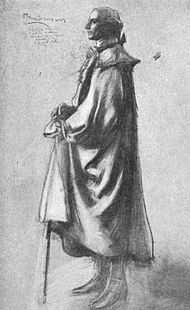Richard Henderson (jurist)

Richard Henderson (1734–1785) was an American pioneer and merchant who attempted to create a colony called Transylvania just as the American Revolutionary War was starting. After the Declaration of Independence (1776) and the organization of the state government in North Carolina, he was re-elected judge, but was prevented from accepting that position by his participation in a scheme organized under the name of the Transylvania Land Company.
Early life
Henderson was born in Hanover County, Virginia Colony. In 1762, he moved to Granville County, North Carolina, studied law, was admitted to the bar, practiced law, and in 1769 was appointed judge of the Superior Court. He was the presiding judge who condemned captured tax resistors to death during the War of the Regulation.[1] Viewed as a member of the gentry, he had been a target of Regulator violence.[1] He was a member of a Church of England parish in Williamsboro during this time.[1]
In the company of wilderness explorers
In 1772, surveyors placed the land officially within the domain of the Cherokee tribe, who required negotiation of a lease with the settlers. Tragedy struck as the lease was being celebrated, when a Cherokee warrior was murdered by a white man. Robertson's skillful diplomacy made peace with the irate Native Americans, who threatened to expel the settlers by force if necessary.
In 1775, a treaty was held between the Cherokee and a delegation of the Transylvania Company, headed by Richard Henderson. Under the Treaty of Sycamore Shoals (or the Treaty of Watauga) the Transylvania Company purchased a vast amount of land from the Cherokees, including most of present-day Kentucky and part of Tennessee. The treaty was technically illegal since the purchase of land from Native Americans was reserved by the government in the Proclamation of 1763 (the British, the governments of Virginia and North Carolina, and, later, the United States, all forbade private purchase of land from Indians).
During the treaty, Dragging Canoe, son of the Cherokee chief Attacullaculla, made a speech condemning the sale of Cherokee land and broke from the general Cherokee tribal government to form the sub-tribe known as the Chickamauga. After Henderson's Transylvania Company had bought Kentucky (although other tribes claimed it, such as the Shawnee), Daniel Boone was hired to widen the Indian path over Cumberland Gap to facilitate migration. This road became known as the Wilderness Road.
The Transylvania Purchase at Sycamore Shoals

The Transylvania Compact

Henderson followed Boone to a site that came to be called Boonesborough, located on the southern bank of the Kentucky river, Henderson encouraged the few settlers there to hold a constitutional convention. In May 1775, under the shade of a huge elm tree, a compact organizing a frame of government was drafted. The intended government entailed executive, legislative, and judicial branches. After concluding the Transylvania Compact, Henderson returned to North Carolina and on behalf of his fellow investors in the land scheme petitioned Congress seeking to make Transylvania America’s fourteenth colony. Despite those efforts, Congress was unwilling to act without the consent of Virginia and North Carolina, both of whom claimed jurisdiction over the region in question. In June 1776 the Virginia General Assembly prohibited the Transylvania Land Company from making demands on settlers in the region and in December 1778 declared the Transylvania claim void.[3]
Henderson and his partners instead received a grant of 12 square miles (31 km²), on the Ohio River below the mouth of Green River.
Post-Revolution
In 1779, Judge Henderson was appointed one of six commissioners to run the line between Virginia and North Carolina into Powell's valley. He settled in North Carolina, where he practiced farming on a large scale. He served as a militia colonel in the Revolutionary War and was elected to the North Carolina General Assembly from Granville County. One of his sons was Leonard Henderson.
Legacy
Henderson County, Illinois was named for Richard Henderson as was Henderson County, Kentucky[4] and its seat Henderson, Kentucky.
References
- ↑ 1.0 1.1 1.2 Bishir, Catherine (2005). North Carolina Architecture. UNC Press. p. 56.
- ↑ Boone: A Biography, Robert Morgan, Algonquin Books, Chapel Hill, 2008, ISBN 978-1-56512-615-2
- ↑ Christian G. Fritz, American Sovereigns: The People and America's Constitutional Tradition Before the Civil War (Cambridge University Press, 2008) at p. 55-60 [ISBN 978-0-521-88188-3
- ↑ The Register of the Kentucky State Historical Society, Volume 1. Kentucky State Historical Society. 1903. p. 35.
- Allen, William B. (1872). A History of Kentucky: Embracing Gleanings, Reminiscences, Antiquities, Natural Curiosities, Statistics, and Biographical Sketches of Pioneers, Soldiers, Jurists, Lawyers, Statesmen, Divines, Mechanics, Farmers, Merchants, and Other Leading Men, of All Occupations and Pursuits. Bradley & Gilbert. pp. 53–54. Retrieved 2008-11-10.
External links
|